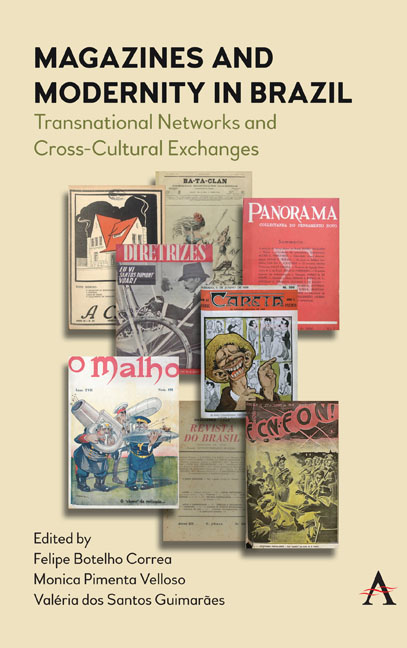Book contents
- Frontmatter
- Contents
- List of Figures
- List of Contributors
- Introduction
- Chapter 1 The French Periodical Print Culture In Brazil: A Survey of Catalogues and Mediators (1800–1945)
- Chapter 2 The Transnational Model of Popular Illustrated Magazines: Three Case Studies from Brazil (1900–20)
- Chapter 3 The Transnational Networks of the Modernist Periodical Print Culture: The Magazine Lumière in the Aftermath of WWI
- Chapter 4 Versions of Modernity in the Household Magazine A Casa (1923– 45)
- Chapter 5 Panorama Magazine and the Far-Right in Brazil (1936–37)
- Chapter 6 Against Nazi-Fascism in Brazil: The Case of the Magazine Diretrizes (1938–44)
- Chapter 7 Literary Inquiries and Disputes on Global Modernism: the Debate in Brazil During WWII
- Chapter 8 Modernity and Modernisms in the Magazine Sombra (1940–60)
- Index
Chapter 2 - The Transnational Model of Popular Illustrated Magazines: Three Case Studies from Brazil (1900–20)
Published online by Cambridge University Press: 04 February 2022
- Frontmatter
- Contents
- List of Figures
- List of Contributors
- Introduction
- Chapter 1 The French Periodical Print Culture In Brazil: A Survey of Catalogues and Mediators (1800–1945)
- Chapter 2 The Transnational Model of Popular Illustrated Magazines: Three Case Studies from Brazil (1900–20)
- Chapter 3 The Transnational Networks of the Modernist Periodical Print Culture: The Magazine Lumière in the Aftermath of WWI
- Chapter 4 Versions of Modernity in the Household Magazine A Casa (1923– 45)
- Chapter 5 Panorama Magazine and the Far-Right in Brazil (1936–37)
- Chapter 6 Against Nazi-Fascism in Brazil: The Case of the Magazine Diretrizes (1938–44)
- Chapter 7 Literary Inquiries and Disputes on Global Modernism: the Debate in Brazil During WWII
- Chapter 8 Modernity and Modernisms in the Magazine Sombra (1940–60)
- Index
Summary
The transformations of the periodical print culture in the Western world at turn of the nineteenth to the twentieth century marked the emergence of the popular illustrated magazine, which can be considered one of the early forms of mass media. It was a period when magazines became consolidated, as media enterprises focused upon a mass number of readers and consumers. These well-printed, inexpensive publications carried a large amount of advertising, and featured photographs, illustrations, caricatures and texts produced by a regular, professional editorial team. This watershed moment was to start in the United States and Europe and then quickly spread to other countries in the Americas, consolidating a transnational model of magazine publishing. This chapter focuses on three case studies from Brazil that explored this model in the first decades of the twentieth century. I will argue that this new readership was in tandem with a growing emphasis on contents with which the unprecedented mass readership could connect and identify. The new popular magazine model fostered new narratives of the Brazilian nation, focusing on the mixed-race, urban individuals from the working and lower middle classes (and their cultural practices) rather than the Romantic image of the indigenous as the personification of the nation throughout the nineteenth century.
From a structure dependent upon local readership, magazines became consolidated in the beginning of the twentieth century as media enterprises focused upon consumers nationwide, which can be explained by a change in the way advertisers were reaching consumers. In the nineteenth century, the sales stream flowed from manufacturer to jobber to retailer to consumer, and advertising was, to a great extent, limited to the last part of this stream. And because the retailer's market was local, not nationwide, the media used to advertise in periodicals were those with close-to-home circulations, rather than the nationally or regionally distributed magazines. This is one of the main reasons for nationwide magazines not carrying a large amount of advertising before the turn of the century.
These new popular illustrated magazines appropriated and engaged with the periodical print culture that emerged in the nineteenth century.
- Type
- Chapter
- Information
- Magazines and Modernity in BrazilTransnational Networks and Cross-Cultural Exchanges, pp. 37 - 56Publisher: Anthem PressPrint publication year: 2020

